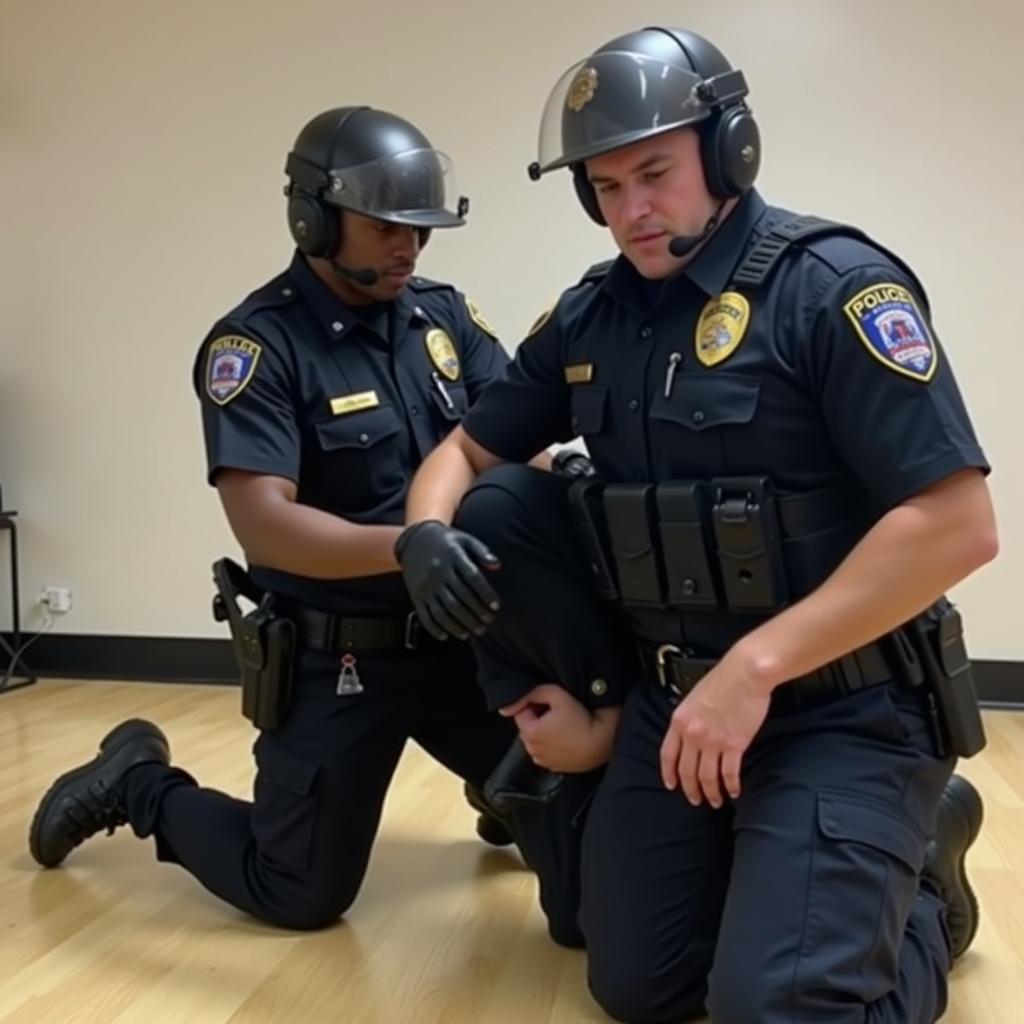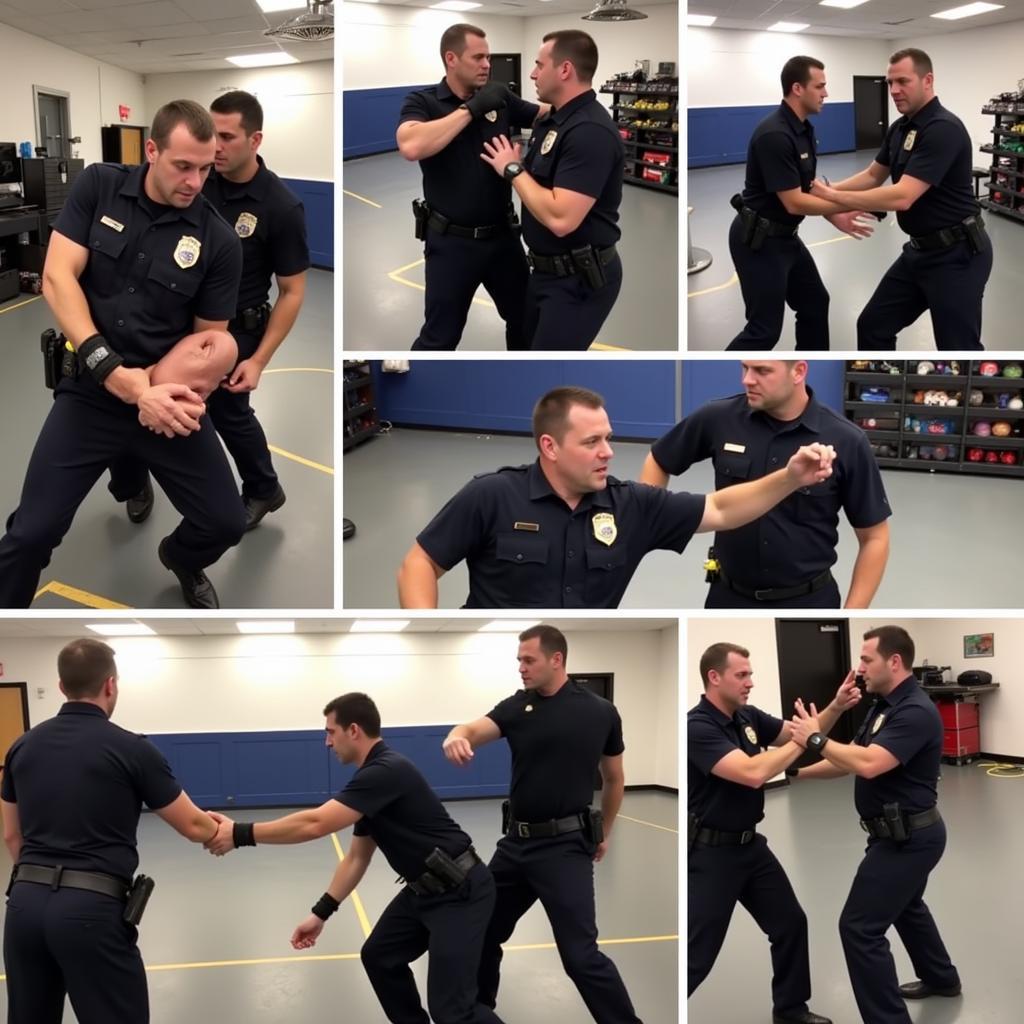Martial Arts for Law Enforcement: Enhancing Officer Safety and Effectiveness
Martial Arts For Law Enforcement plays a crucial role in ensuring officer safety and effectiveness in the field. This article explores the benefits, training considerations, and the impact of martial arts on modern policing. martial arts police
 Police officer practicing martial arts techniques during a training session
Police officer practicing martial arts techniques during a training session
Why Martial Arts are Essential for Law Enforcement
Martial arts provide officers with a range of practical skills applicable to diverse situations. These disciplines enhance physical fitness, improve situational awareness, and equip officers with effective self-defense techniques. From controlling resisting suspects to de-escalating potentially violent encounters, martial arts training offers a valuable skillset. Furthermore, proficiency in martial arts can boost an officer’s confidence and composure under pressure, leading to better decision-making in critical moments.
Building Confidence and Control
The rigorous training involved in martial arts instills discipline and mental fortitude. This helps officers maintain composure in stressful situations, enabling them to make rational decisions even when facing threats.
 Benefits of martial arts for law enforcement officers
Benefits of martial arts for law enforcement officers
Martial arts also cultivate a deep understanding of body mechanics, leverage, and pressure points, allowing officers to use minimal force while effectively controlling a situation. This not only reduces the risk of injury to both the officer and the suspect, but also promotes a more professional and respectful approach to law enforcement. Have you ever considered the impact of improved self-control on an officer’s ability to de-escalate a tense situation?
Choosing the Right Martial Arts Style for Police Work
Several martial arts styles are particularly well-suited for law enforcement, each offering unique advantages. Judo, for example, emphasizes grappling and takedown techniques, while Aikido focuses on redirecting an attacker’s energy. Brazilian Jiu-Jitsu is highly effective in close-quarters combat and ground fighting, providing officers with tools to control and subdue suspects safely. The selection of a specific style should align with the department’s needs and the types of situations officers are most likely to encounter.
Key Considerations for Law Enforcement Training
Effective martial arts training for law enforcement goes beyond simply learning techniques. It must encompass realistic scenario-based training that simulates the dynamic and unpredictable nature of real-world encounters. This includes practicing techniques in full gear, under stress, and against resisting opponents. Regular drills and ongoing practice are crucial for maintaining proficiency and ensuring that officers can instinctively apply their skills when needed.
“Consistent training is not just about physical preparedness,” says John Smith, a veteran law enforcement trainer with 20 years of experience, “it’s about cultivating a mindset of readiness and adaptability.”
The Future of Martial Arts in Policing
As policing evolves, so too will the role of martial arts. law enforcement art The increasing emphasis on de-escalation tactics and minimizing the use of force necessitates a refined approach to martial arts training. Future training programs are likely to incorporate more elements of conflict resolution, communication skills, and psychological awareness alongside physical techniques. This holistic approach will better equip officers to navigate complex situations and serve their communities effectively. “The future of law enforcement lies in finding the balance between effective control and compassionate interaction,” explains Maria Garcia, a leading researcher in police training methodologies.
Conclusion
Martial arts for law enforcement is not simply about fighting; it’s about empowering officers with the skills and confidence to protect themselves, control volatile situations, and serve their communities effectively. By embracing a comprehensive approach to training and continually adapting to the evolving landscape of law enforcement, agencies can maximize the benefits of martial arts and ensure officer safety and effectiveness in the field.
FAQ
- What are the most effective martial arts for police?
- How does martial arts training benefit law enforcement officers?
- What should be included in a police martial arts training program?
- How often should police officers practice their martial arts skills?
- What are the future trends in martial arts training for law enforcement?
- How does martial arts training contribute to de-escalation tactics?
- Can martial arts training improve an officer’s decision-making under pressure?
Common Scenarios where Martial Arts are Useful for Law Enforcement
- Arresting a resisting suspect: Techniques learned in martial arts can help officers safely control and subdue individuals who are resisting arrest, minimizing the risk of injury to both parties.
- Responding to a physical altercation: Martial arts training can provide officers with the tools to defend themselves and others in situations involving physical violence.
- Controlling a potentially dangerous individual: Officers can utilize martial arts techniques to restrain and control individuals who pose a threat to themselves or others, while minimizing the use of excessive force.
- De-escalating tense situations: The discipline and self-control cultivated through martial arts training can help officers remain calm and composed in stressful situations, promoting peaceful resolutions.
Further Exploration
Explore more about career in martial arts.
Need assistance? Contact us 24/7: Phone: 02462573573, Email: danteum@gmail.com or visit us at Savico Megamall, 7-9 Đ. Nguyễn Văn Linh, Gia Thụy, Long Biên, Hà Nội 10000, Việt Nam.


